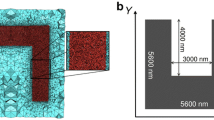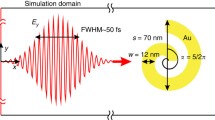Abstract
We present a perturbative approach to the time-domain computation of three-wave-mixing signals from plasmonic nanostructures. Based on a hydrodynamic material model which features nonlinear as well as nonlocal characteristics, we compute the ultrafast response of electrons in metals in a perturbative manner, where fundamental waves and second-order response are evaluated separately. This allows us to examine the source distribution of the second-order nonlinear response originating from the fundamental waves in a consistent manner that takes the nonlocal characteristics of the system into account. We validate this framework by comparing with the results of the fully nonlinear model and apply it to the study of three-wave-mixing enhancements from nanoplasmonic antennas.









Similar content being viewed by others
References
M. Kauranen, A.V. Zayats, Nonlinear plasmonics. Nat. Photon. 6, 737–748 (2012)
N.B. Grosse, J. Heckmann, U. Woggon, Nonlinear plasmon-photon interaction resolved by k-space spectroscopy. Phys. Rev. Lett. 108(13), 136802 (2012)
M. Corvi, W.L. Schaich, Hydrodynamic-model calculation of second-harmonic generation at a metal surface. Phys. Rev. B 33, 3688–3695 (1986)
J.E. Sipe, V.C.Y. So, M. Fukui, G.I. Stegeman, Analysis of second-harmonic generation at metal surfaces. Phys. Rev. B 21, 4389–4402 (1980)
N. Bloembergen, Nonlinear optics and spectroscopy. Rev. Mod. Phys. 54, 685–695 (1982)
J.A. Armstrong, N. Bloembergen, J. Ducuing, P.S. Pershan, Interactions between light waves in a nonlinear dielectric. Phys. Rev. 127, 1918–1939 (1962)
N.A. Mortensen et al., A generalized non-local optical response theory for plasmonic nanostructures. Nat. Commun. 5, 3809 (2014). doi:10.1038/ncomms4809
T. Christensen, W. Yan, S. Raza, A.-P. Jauho, N.A. Mortensen, M. Wubs, Nonlocal response of metallic nanospheres probed by light, electrons, and atoms. ACS Nano 8(2), 1745–1758 (2014)
C. Ciracì, J.B. Pendry, D.R. Smith, Hydrodynamic model for plasmonics: a macroscopic approach to a microscopic problem. ChemPhysChem 14(6), 1109–1116 (2013)
G. Toscano, S. Raza, A.P. Jauho, N.A. Mortensen, M. Wubs, Modified field enhancement and extinction by plasmonic nanowire dimers due to nonlocal response. Opt. Express 20(4), 4176–4188 (2012)
K.R. Hiremath, L. Zschiedrich, F. Schmidt, Numerical solution of nonlocal hydrodynamic drude model for arbitrary shaped nano-plasmonic structures using ndlec finite elements. J. Comput. Phys. 231(17), 5890–5896 (2012)
S. Raza, G. Toscano, A.-P. Jauho, M. Wubs, N.A. Mortensen, Unusual resonances in nanoplasmonic structures due to nonlocal response. Phys. Rev. B 84, 121412 (2011)
I. Villó-Pérez, N.R. Arista, Hydrodynamical model for bulk and surface plasmons in cylindrical wires. Surf. Sci. 603(1), 1–13 (2009)
R. Ruppin, Extinction properties of thin metallic nanowires. Opt. Commun. 190(1), 205–209 (2001)
P. Ahlqvist, P. Apell, On the hydrodynamical theory for surface plasmons. Phys. Scr. 25(4), 587 (1982)
A. Eguiluz, J.J. Quinn, Hydrodynamic model for surface plasmons in metals and degenerate semiconductors. Phys. Rev. B 14, 1347–1361 (1976)
J.A. Maytorena, W.L. Mochán, B.S. Mendoza, Hydrodynamic model for second-harmonic generation at conductor surfaces with continuous profiles. Phys. Rev. B 51, 2556–2562 (1995)
J.A. Maytorena, W.L. Mochán, B.S. Mendoza, Hydrodynamic model for sum and difference frequency generation at metal surfaces. Phys. Rev. B 57, 2580–2585 (1998)
K. Huang, Statistical Mechanics (Wiley, London, 1987)
M. Wakano, Foundations for a treatment of the scattering of light by the hydrodynamical and statistical atom model. J. Math. Phys. 2(6), 803–824 (1961)
P. Halevi, Hydrodynamic model for the degenerate free-electron gas: generalization to arbitrary frequencies. Phys. Rev. B 51, 7497–7499 (1995)
A. Hille, M. Moeferdt, C. Wolff, C. Matyssek, R. Rodrguez-Oliveros, C. Prohm, J. Niegemann, S. Grafström, L.M. Eng, K. Busch, Second harmonic generation from metal nano-particle resonators: numerical analysis on the basis of the hydrodynamic drude model. J. Phys. Chem. C 120(2), 1163–1169 (2016)
N. Bloembergen, R.K. Chang, S.S. Jha, C.H. Lee, Optical second-harmonic generation in reflection from media with inversion symmetry. Phys. Rev. 174, 813–822 (1968)
J.S. Hesthaven, T. Warburton, Nodal Discontinuous Galerkin Methods: Algorithms, Analysis, and Applications (Springer, Berlin, 2007)
P.B. Johnson, R.W. Christy, Optical constants of the noble metals. Phys. Rev. B 6, 4370–4379 (1972)
K. Busch, M. König, J. Niegemann, Discontinuous galerkin methods in nanophotonics. Laser Photon. Rev. 5(6), 773–809 (2011)
S.G. Johnson, Notes on perfectly matched layers (PMLs). Lecture notes, vol. 5, no. 5.3 (Massachusetts Institute of Technology, Massachusetts, 2008), p. 2
J. Schöberl, Netgen an advancing front 2d/3d-mesh generator based on abstract rules. Comput. Vis. Sci. 1(1), 41–52 (1997)
A. Taflove, S.C. Hagness, Computational Electrodynamics (Artech House, Norwood, MA, 2000)
A. Sundaramurthy, K.B. Crozier, G.S. Kino, D.P. Fromm, P.J. Schuck, W.E. Moerner, Field enhancement and gap-dependent resonance in a system of two opposing tip-to-tip au nanotriangles. Phys. Rev. B 72, 165409 (2005)
Author information
Authors and Affiliations
Corresponding author
Additional information
This article is part of the topical collection “Ultrafast Nanooptics” guest edited by Martin Aeschlimann and Walter Pfeiffer.
Rights and permissions
About this article
Cite this article
Huynh, DN., Moeferdt, M., Matyssek, C. et al. Ultrafast three-wave-mixing in plasmonic nanostructures. Appl. Phys. B 122, 139 (2016). https://doi.org/10.1007/s00340-016-6411-2
Received:
Accepted:
Published:
DOI: https://doi.org/10.1007/s00340-016-6411-2




